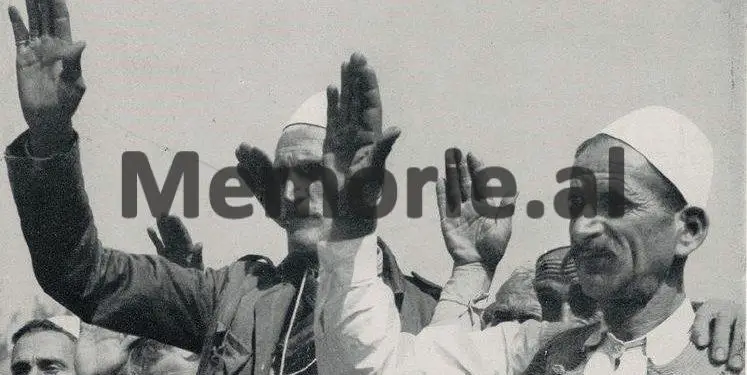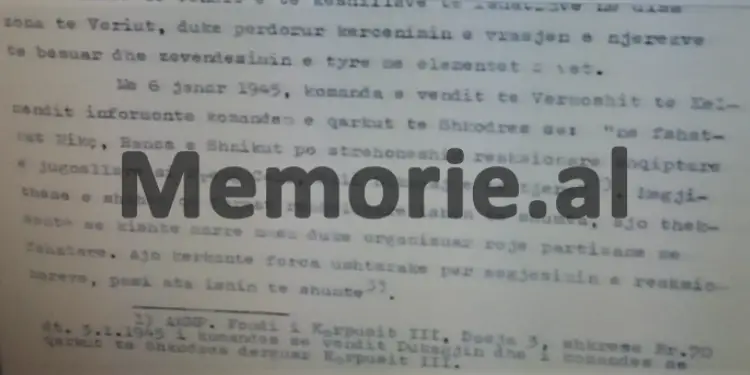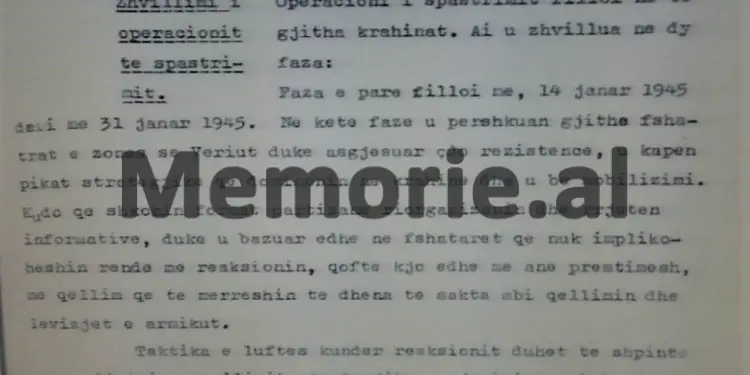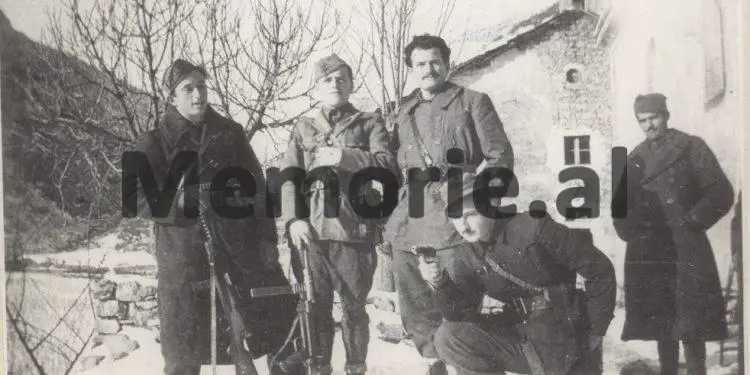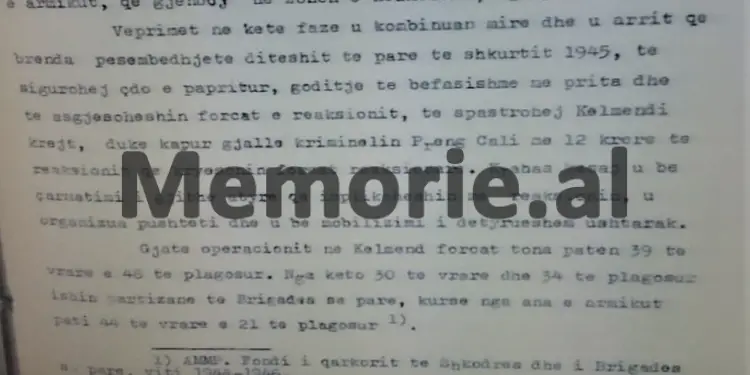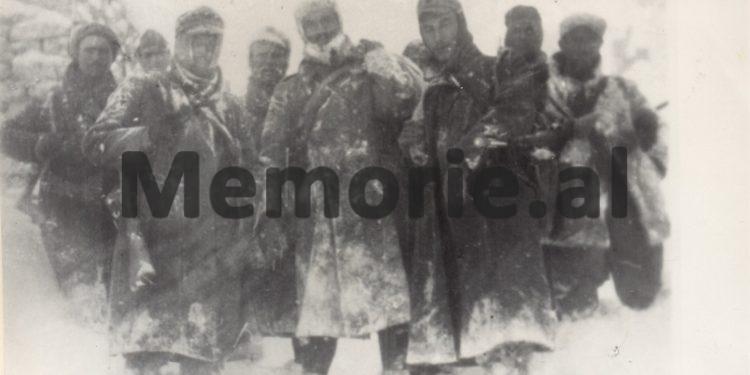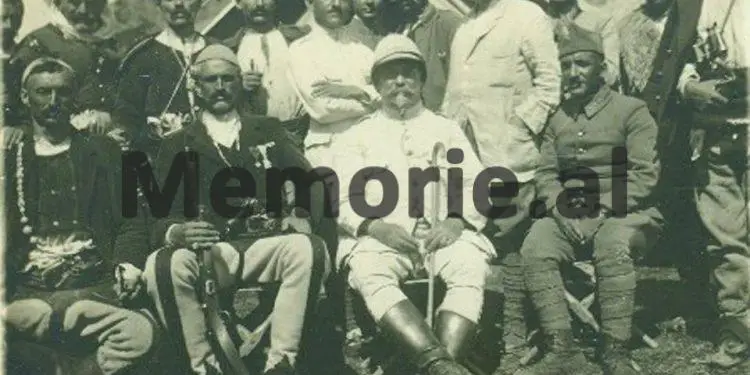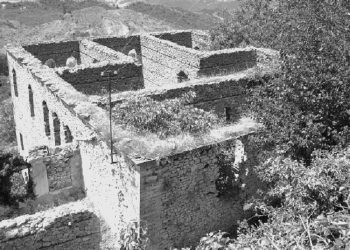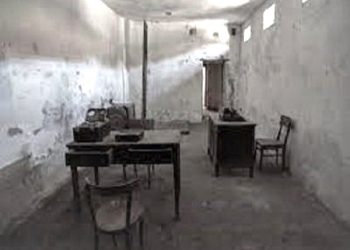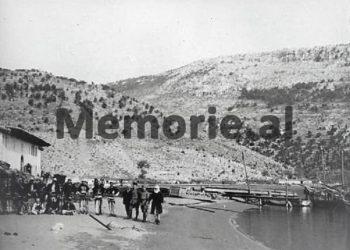Dashnor Kaloçi
Memorie.al/publishes an unknown archival document extracted from the Archive of the Ministry of Internal Affairs in Tirana, where there is information with the logo “Top secret” of the State Security Directorate, where it is about the maneuvers that were used for the arrest of Prek Cali on February 14, 1945, where it is stated, among other things: “On January 6, 1945, the command of Vermoshi and Kelmendi informed the command of the Shkodra Region that: Yugoslavs such as Preng Cali, Sali Nikçaj, etc. During this phase, the Intelligence Service stated that the fight against the partisan forces was given by Zef Nika, Ujk Lula and Preng Doda from Vukli, who were captured. “Nikol Tona and Nik Marashi were also caught and executed, who had killed the couriers of the First Brigade who were sent on duty to Vukël”.
76 years ago, after a nearly two-month siege of the Kelmendi province in the about Shkodra Highlands, numerous partisan forces of the First Assault Brigade, which was then under the command of the 3rd Corps and led that operation, arrested Prek Calin and 12 other men, who accompanied him. This event caused a great commotion at that time, not only because of the name and the extraordinary authority that Prek Cali had, but also because of the great losses they suffered as the partisan forces of the First Assault Brigade, who were forced to march in the areas as well. Albanians under Montenegro, for his siege, as well as for the people who accompanied Prek Cal, during that time almost three months that he was forced to stay in the mountains on the run.
Much has been said and written about Prek Cal, or especially about this event, only after the 90s and also only a few days ago, the President of the Republic, Mr. Ilir Meta, praised Prek Cal with the highest medal, ‘Honor of the Nation’, as well as some other patriotic figures from Malësia e Madhe.
Above, in this article we are publishing a secret document of the Ministry of Internal Affairs, which shows how Prek Cali and the people who accompanied him were arrested, on February 14, 1945. We have taken this document from a study long (over 1200 pages) prepared by a working group of the Ministry of Internal Affairs, before the ’90s, (chaired by Themi Bare.), which reflected all the “successes of the State Security” by the year 1943 when the first nucleus of the State Security was created, until the mid-80s.
The whole study in question was “Top secret” and it was used as a special subject for students of the School of the Ministry of Internal Affairs (Insurance Branch), until 1990. Although the whole study is full of a lot of propaganda, there is abundant and highly detailed material on how the “State Security weapon” has functioned since its inception until the mid-1980s. The document in question for Prek Calin, is published for the first time by Memorie.al.
The secret document of the State Security, for the arrest of Prek Cali, on February 14, 1945
Meanwhile, the country’s commander informed that the reactionaries had withdrawn many people from the people, fearing that their houses and children would be burned if they helped the Defense. The data showed the preparation the reaction was making.
“In our region,” wrote the Dukagjini country command, on January 3, 1945, the situation is critical. Various blood elements are brought through the villages…?! The situation is developing in such a way that war can start. “Send military forces.” The records said that, in addition to reactionary clerics, influential party bayraktars, war criminals and foreign agencies, who had been thrown into armed struggle against popular power, the reaction attracted other people to the war, exploiting not only them who had compromised with the reaction, but also their friendly ties, tariffs and tribes, exploited old customs and traditions. Enemies had also shot at many people of the country councils and village councils in many areas of the North, using the threats of trusted people and replacing them with their own elements.
On January 6, 1945, the command of the country of Vermoshi and Kelmendi, informed the command of the region of Shkodra, that: (M.M.P. Archive, III Corps Fund, File 3, letter No. 70, dated 3.1.1945, of the Dukagjin Country Command and the Shkodra District Command, sent to the III Corps).
Although she saw that the reactionary forces were numerous, she stressed that she had taken measures by organizing partisan guards with villagers. It required military force to annihilate the reactionaries, as they were numerous.
In this way, the country’s commands, along with other people’s defense bodies, not only performed the task of informing and maintaining order and peace, but also took measures to search, prosecute and eliminate criminals.
At the same time, seeing that the criminals had deceived many innocent people, who, as a result of the reaction work, had fled, the country commands, in addition to annihilation by armed forces, also used convincing forms of work, being called for the surrender of the fugitives, through meetings with the fugitives who had influence, where the “agreement” for surrender was made. Country commands also made lists of fugitives. These lists were sent to the district commands, the ombudsman, who forwarded them to the ombudsman of the province. This affected the purge operation successfully.
In line with the peculiarities of the fight against internal reaction, the operation in these provinces was not uniform. In the North, the reaction operated with large groups of criminals from 50 to 400 people, armed and well organized, while in the South and Central Albania, in small, detached groups. In the North, the reaction was preparing to resist by fighting with weapons, while in the South, it organized acts of terror, diversion and sabotage. This made it necessary for the tactics of the actions of our forces, to be adapted to that of the enemy, to act in small groups, to be answered in the same way. It made no sense to engage an entire division or brigade in organizing, encircling, and destroying a small group.
For this reason, while large formations of the National Liberation Army were operating in the North, in the areas of the South and Central Albania, small groups were organized with brave, agile and loyal partisans, who together with the people, the commands of the country, the national liberation councils, the pursuit and protection units of the people, organized ambushes, captured or annihilated, groups of fugitive criminals. “Here should be used those who have old personal animosities, for information” – said Comrade Hysni Kapo, Commissar of the First Corps, in the instructions he sent to the organs and units on 24.1.1945.
In some Northern provinces, such as Hoti, Kelmendi, Gruda, as a result of the deception committed by the enemy, many people had risen in open resistance and refused to join the ranks of the U.N.Ç.SH. Among them, as in the Malësia of Shkodra, Gjakova, etc., they held an indifferent attitude towards the popular power. The remnants of the reaction in these areas were armed with rifles and machine guns and waited for the opportunity to engage in counter-revolutionary activity. In these areas as well as in others where the reaction was grounded, the enemy chanted slogans to create distrust of the democratic government, discontent and disunity among the people. “The remnants of the reaction in Albania have gathered themselves and are carrying out multifaceted activity”, stressed Comrade Enver Hoxha in the order of the operation of January 19, 1945, sent to the Headquarters of the 3rd Corps.
The popular power in the area of Shkodra and Kukes had not yet strengthened its bases, it was always threatened by reaction. This was because the partisan forces of the 3rd Corps had not yet passed through all the villages. “If measures are not taken”, instructed Comrade Enver Hoxha, these reactionary forces and the nursery of reaction can become a hotbed of reactionary movement and threaten power. Studying this situation, Comrade Enver Hoxha ordered the forces of the 3rd Corps to pass through all the sub-prefectures of Shkodra Region and Kukës, the sub-prefecture of Peshkopi, to eliminate and annihilate any organized reactionary force or not.
Development of the cleaning operation
The cleansing operation began in all the provinces. It took place in two phases: The first phase began on January 14, 1945 until January 31, 1945. In this phase all the villages of the Northern area were traversed, destroying any resistance, capturing the strategic points that dominated the province and became mobilization. Wherever the partisan forces went, they reorganized the information network, relying on the villagers who were not heavily involved in the reaction, be it through promises, in order to gather accurate data on the enemy’s intentions and movements.
The tactics of fighting the reaction were to lead to the realization of the strategic goal: the complete annihilation of the reaction. For this reason, during the operation, the tactic of war, siege maneuver was used.
During the first phase, as a result of the lack of good organization, counterintelligence service and lack of data on the state, purpose and movement of the reaction, our military forces suffered heavy losses… ?! From failing to take detective measures, they often fell into sudden ambushes.
(The order that Comrade Enver sent on January 19, 1945, to trespass and purge all the villages of the North, the Headquarters of the 3rd Corps had not carried out). This was due to the fact that the reaction was underestimated and that the number of our forces, which were sent to pursue and eliminate him in these areas, was less than the number of fugitive criminals: the strategic terrain unknown to our forces could not be identified the ambushes and surprises that armed bandits inflicted on our forces.
The enemy, knowing well the terrain, had been able to occupy all the dominant points of the roads. Also, the lack of tactical knowledge of those responsible for leading the operation in these areas, led to not combining the activity of their forces with other forces, so that these go in parallel. All this came from the lack and non-evaluation of the information network.
This weakness as well as the losses suffered by our forces in the first phase were corrected in the second phase, which began from 1 to 14 February 1945. During this phase, the forces of U.N.Ç.SH. (Albanian National Liberation Army), crossing the great natural obstacles, crossing the peaks, necks and gorges covered with snow, in support of reliable data, which had been collected by the field intelligence service, by villagers and detectives who were sent to the deep areas, made the blows of the enemy, located in the area of Kelmendi, from five directions.
The actions at this stage were well combined and made that within the first fifteen days of February 1945, every surprise, sudden blow to the ambush was secured and the reaction forces were annihilated, Kelmendi was completely cleansed and Preng Cali was captured alive. With 12 reaction heads leading the reactionary forces. In addition, all those implicated in the reaction were disarmed, power was organized, and military mobilization was mandatory.
During the operation in Kelmend, our forces had 39 killed and 48 wounded. Of these, 30 killed and 34 wounded, were partisans of the First Brigade, while on the enemy side, there were 44 killed and 21 wounded. (1. M.M.P. Archive and the Shkodra Regional Fund and the First Brigade 1944-1946).
During this phase, the Intelligence Service stated that the fight against the partisan forces was given by Zef Nika, Ujk Lula and Preng Doda from Vukli, who were captured. Also arrested and executed were Nikol Tona and Nik Marashi, who had killed the couriers of the First Brigade, who were sent on duty to Vukël.
In addition, the families of the reactionaries were interned, 12 instigators and the main perpetrators of the reaction were arrested in Kelmendi.
As always and during the operation in Kelmend, the Party paid great attention to the political, persuasive, educational work, in the masses of the people to clarify them about the actions of the military forces and the actions of the criminal Preng Cali.
Thus, Kelmendi in this operation, knew well the justice of the line of the Albanian Communist Party. Kelmendi who had been constantly under the influence of the reaction, which was the only place without being violated by the forces of U.N.Ç.SH. until the start of the operation, it became an important hotbed for the extermination of criminals.
The strongest reaction and resistance was in the two Bajraks of Kelmendi, Nikç and Vukël.
In the fight for the annihilation of the armed forces of the reaction, the forces and units of the U.N.Ç.SH. used tactics, perimeter maneuver and lightning strike. For this, data was first collected, sifted, sieged, groups of attackers sent, and struck simultaneously from all directions. Here all the waste of the reaction began to be collected and organized. The reaction was harsh, especially in Broja, Tamara Bridge, etc. But here and they were completely annihilated.
The entry of the forces of U.N.Ç.SH. suddenly from different directions, aroused panic throughout the reaction. This caused any resistance to be extinguished upon first seeing the forces of the U.N.Ç.SH. All the men from the villages of Kelmendi, especially Broja and Rahovica, who had left their families as a result of the reaction work, returned.
Fair, prudent and correct actions with the people, as well as the vivid capture of the leaders of the reaction, brought the people closer to the SEMPs (People’s Defense Sections), and became the main basis and support for the discovery of all other hidden criminals and traitors. /Memorie.al




